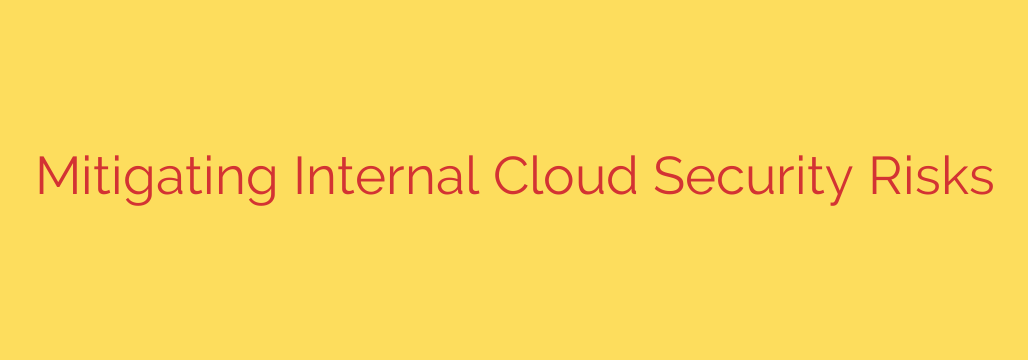
The Threat Within: A Guide to Securing Your Cloud from Insider Risks
When businesses think about cybersecurity, they often picture a digital fortress, with high walls and a deep moat designed to keep external attackers out. But what happens when the most significant threat is already inside the gates? As organizations increasingly migrate to the cloud, the risk posed by internal actors—whether malicious or simply negligent—has become one of the most pressing challenges in modern security.
Focusing solely on external threats leaves your most valuable cloud assets dangerously exposed. A comprehensive security strategy must look inward to effectively mitigate the risks that come from trusted users.
Understanding the Spectrum of Internal Cloud Threats
An “insider threat” isn’t just a disgruntled employee looking for revenge. The reality is more complex and encompasses three primary categories:
- Malicious Insiders: These are current or former employees, contractors, or partners who intentionally use their authorized access to steal data, disrupt services, or cause financial harm. Their motives can range from financial gain to corporate espionage or simple vengeance.
- Negligent or Accidental Insiders: This is the most common type of internal threat. These are well-meaning employees who inadvertently expose the organization to risk through simple errors. This can include clicking a phishing link, misconfiguring a cloud service, or accidentally sharing sensitive data publicly.
- Compromised Insiders: In this scenario, an external attacker gains control of a legitimate employee’s credentials. To the system, they appear as a trusted user, allowing them to move through the network, escalate privileges, and exfiltrate data while bypassing perimeter defenses.
Core Strategies for Mitigating Internal Cloud Risks
Traditional security models that rely on a hardened perimeter are no longer sufficient in the distributed, access-anywhere world of the cloud. A modern, robust security posture requires a multi-layered approach centered on identity, access, and continuous verification.
1. Embrace the Principle of Least Privilege (PoLP)
The single most effective strategy for reducing insider risk is ensuring that every user has only the minimum level of access necessary to perform their job. The Principle of Least Privilege (PoLP) dictates that no one should have default access to sensitive data or critical systems. Access must be explicitly granted, time-bound, and regularly reviewed. If a negligent employee can’t access a critical database, they can’t accidentally delete it. If a compromised account has limited permissions, the attacker’s blast radius is significantly contained.
2. Implement a Zero Trust Security Model
The core philosophy of Zero Trust is simple but powerful: “never trust, always verify.” This model assumes that threats can exist both outside and inside the network. It eliminates the idea of a trusted internal network and instead requires continuous verification for any user or device attempting to access a resource. Every access request is authenticated, authorized, and encrypted before being granted. This approach is critical for preventing a compromised user from moving laterally across your cloud environment.
3. Strengthen Identity and Access Management (IAM)
Your IAM policy is the engine that drives both PoLP and Zero Trust. A strong IAM framework is non-negotiable for cloud security. Key components include:
- Multi-Factor Authentication (MFA): Enforce MFA across all services to protect against compromised credentials. A password alone is not enough.
- Role-Based Access Control (RBAC): Define roles with specific, granular permissions instead of assigning them to individuals. This simplifies managing and auditing access.
- Regular Access Reviews: Periodically audit who has access to what. Promptly revoke permissions for employees who change roles or leave the company.
4. Maintain Continuous Monitoring and Threat Detection
You cannot stop a threat you cannot see. Comprehensive logging and monitoring of all activities within your cloud environment are essential for detecting anomalous behavior. Look for signs that indicate an insider threat, such as:
- A user accessing data they have never touched before.
- Unusual login times or locations.
- Large-scale data downloads or deletions.
- Attempts to escalate privileges.
Tools like User and Entity Behavior Analytics (UEBA) can help automate this process by establishing a baseline of normal activity and flagging deviations that may signal a threat.
5. Prioritize Security Awareness and Training
The human element is often the weakest link. To combat the risk of the negligent insider, ongoing security training is crucial. Educate your employees on recognizing phishing attempts, practicing good password hygiene, understanding data classification policies, and reporting suspicious activity immediately. A well-informed workforce is your first line of defense against both accidental errors and social engineering attacks designed to compromise their accounts.
6. Automate Cloud Security Posture Management (CSPM)
Cloud environments are dynamic and complex, making manual configuration checks nearly impossible. A single misconfigured S3 bucket or an overly permissive firewall rule can lead to a catastrophic breach. Automated CSPM tools continuously scan your cloud infrastructure for misconfigurations, compliance violations, and security vulnerabilities, providing real-time alerts so your team can remediate issues before they can be exploited.
Moving Toward Proactive Cloud Defense
Securing the cloud is not a one-time project but an ongoing commitment. By shifting the focus from a purely external defense to a holistic strategy that addresses internal risks, organizations can build a more resilient and secure digital infrastructure.
Implementing Zero Trust principles, enforcing least privilege, and empowering your team with training and powerful monitoring tools transforms your security posture from reactive to proactive. In today’s threat landscape, assuming trust is a liability. The key to true cloud security is to verify everything and protect your critical assets from the inside out.
Source: https://www.tripwire.com/state-of-security/preventing-preventable-tackling-internal-cloud-security-risks








